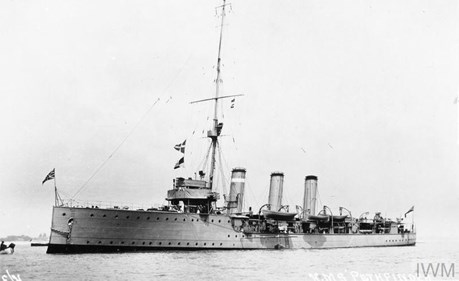South Warwickshire Family History Society War Memorial Transcription Project |
|
|
|
Military History |
| Theatre of War | Medals | Commonwealth War Grave or Memorial |
|---|---|---|
| North Sea | 1914 Star, British War & Victory Medals | Chatham Naval Memorial |
| Arrived in Theatre | Medal Citation (if app) | SWFHS Area Memorials |
| 5 Aug 1914 | ~ | Rowington |
| Temple Balsall | ||
| Action, Battle or Other Reason Killed | Date and Place Enlisted | Balsall Common |
| Navy Actions in Firth of Forth | 28 Apr 1913 at Birmingham | |
| Other War Memorials | ||
| Place of Death | Previous Regiments or Units | |
| North Sea off Rosyth | Chatham Division RMLI | Click here for Service Record |
Circumstances Leading to Death (Normally from War Diary)
|
William was serving aboard HMS Pathfinder when it was struck by a Torpedo fired by German Submarine U21. The following is taken from Wikipedia At the beginning of September 1914, Otto Hersing, Commanding Officer of U-21, ventured to the Firth of Forth, home to the major British naval base at Rosyth. Hersing is known to have penetrated the Firth of Forth as far as the Carlingnose Battery beneath the Forth Bridge. At one point the periscope was spotted and the battery opened fire but without success. Overnight Hersing withdrew from the Forth, patrolling the coast from the Isle of May southwards. On the morning of 5 September, he observed HMS Pathfinder on a south-southeast course, followed by elements of the 8th Destroyer Flotilla. At midday, the destroyers altered course back towards the Isle of May while Pathfinder continued her patrol. Shortly thereafter, Hersing spotted Pathfinder on her return journey through his periscope and resolved to make an attack. At 1543 U-21 fired a single 50 cm (20 in) Type G/6 torpedo at a range of 2,000 yards. At 1545 lookouts spotted a torpedo wake heading towards the starboard bow and the officer of the watch, Lieutenant-Commander Favell, attempted to take evasive action by ordering the starboard engine be put astern and the port engine at full ahead while the wheel was turned hard a port, the manoeuvre was not in time and the torpedo struck the ship beneath the bridge. The detonation apparently set off cordite bags in the forward magazine which caused a second, more massive explosion within the fore section of the ship, essentially destroying everything forward of the bridge. Broken in two, the Pathfinder instantly began sinking, dragging most of her crew down with her and leaving a massive pall of smoke to mark her grave. The vessel sank so quickly, in fact, that there was insufficient time to launch lifeboats. (Indeed, the remains of a lifeboat davit and rope can still be seen on the wreck, demonstrating the speed with which the vessel sank.)
There is significant confusion regarding the numbers of survivors. On 6 September The Times declared that 58 men had been rescued but that four had died of injuries. The fact that it is impossible to determine how many were on board that day adds to the problem, but modern research indicates that in all probability, there were 268 personnel on board plus two civilian canteen assistants. There were just twenty known survivors. Four more men died of injuries or exposure and are buried at Dalmeny in Fife and Warriston near Edinburgh. One unknown Pathfinder sailor is buried at Dunbar overlooking the scene of the sinking. |
| Personal & Family History |
| Birth Date/Place | Baptism Date/Place |
|---|---|
| 30 Oct 1895 at Rowington | 7 Nov 1895 at Baddesley Clinton |
| Parents Names | Abode |
| John and Annie Wright | The Yard, Chadwick End, Knowle |
| Schools | Colleges |
| ~ | |
| Address History | Employment History |
| 1895 - Rowington | 1911 - Works Labourer |
| 1901 - Rowington | 1913 - Royal Marine |
| 1911 - Chadwick End | |
| 1914 - The Yard, Chadwick End, Knowle | |








